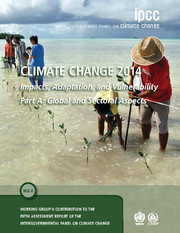 Climate Change 2014 – Impacts, Adaptation and Vulnerability: Part A: Global and Sectoral Aspects
Climate Change 2014 – Impacts, Adaptation and Vulnerability: Part A: Global and Sectoral Aspects Book contents
- Frontmatter
- Contents
- Foreword, Preface, and Dedication
- Summary for Policymakers
- Technical Summary
- Cross-Chapter Boxes
- Chapters 1-20
- Chapter 1 Point of Departure
- Chapter 2 Foundations for Decision Making
- Chapter 3 Freshwater Resources
- Chapter 4 Terrestrial and Inland Water Systems
- Chapter 5 Coastal Systems and Low-Lying Areas
- Chapter 6 Ocean Systems
- Chapter 7 Food Security and Food Production Systems
- Chapter 8 Urban Areas
- Chapter 9 Rural Areas
- Chapter 10 Key Economic Sectors and Services
- Chapter 11 Human Health: Impacts, Adaptation, and Co-Benefits
- Chapter 12 Human Security
- Chapter 13 Livelihoods and Poverty
- Chapter 14 Adaptation Needs and Options
- Chapter 15 Adaptation Planning and Implementation
- Chapter 16 Adaptation Opportunities, Constraints, and Limits
- Chapter 17 Economics of Adaptation
- Chapter 18 Detection and Attribution of Observed Impacts
- Chapter 19 Emergent Risks and Key Vulnerabilities
Chapter 11 - Human Health: Impacts, Adaptation, and Co-Benefits
Published online by Cambridge University Press: 05 January 2015
- Frontmatter
- Contents
- Foreword, Preface, and Dedication
- Summary for Policymakers
- Technical Summary
- Cross-Chapter Boxes
- Chapters 1-20
- Chapter 1 Point of Departure
- Chapter 2 Foundations for Decision Making
- Chapter 3 Freshwater Resources
- Chapter 4 Terrestrial and Inland Water Systems
- Chapter 5 Coastal Systems and Low-Lying Areas
- Chapter 6 Ocean Systems
- Chapter 7 Food Security and Food Production Systems
- Chapter 8 Urban Areas
- Chapter 9 Rural Areas
- Chapter 10 Key Economic Sectors and Services
- Chapter 11 Human Health: Impacts, Adaptation, and Co-Benefits
- Chapter 12 Human Security
- Chapter 13 Livelihoods and Poverty
- Chapter 14 Adaptation Needs and Options
- Chapter 15 Adaptation Planning and Implementation
- Chapter 16 Adaptation Opportunities, Constraints, and Limits
- Chapter 17 Economics of Adaptation
- Chapter 18 Detection and Attribution of Observed Impacts
- Chapter 19 Emergent Risks and Key Vulnerabilities
Summary
11.1. Introduction
This chapter examines what is known about the effects of climate change on human health and, briefly, the more direct impacts of climate-altering pollutants (CAPs; see Glossary) on health. We review diseases and other aspects of poor health that are sensitive to weather and climate. We examine the factors that influence the susceptibility of populations and individuals to ill health due to variations in weather and climate, and describe steps that may be taken to reduce the impacts of climate change on human health. The chapter also includes a section on health “co-benefits.” Co-benefits are positive effects on human health that arise from interventions to reduce emissions of those CAPs that warm the planet or vice versa.
This is a scientific assessment based on best available evidence according to the judgment of the authors. We searched the English-language literature up to August 2013, focusing primarily on publications since 2007. We drew primarily (but not exclusively) on peer-reviewed journals. Literature was identified using a published protocol (Hosking and Campbell-Lendrum, 2012) and other approaches, including extensive consultation with technical experts in the field. We examined recent substantial reviews (e.g., Gosling et al., 2009; Bassil and Cole, 2010; Hajat et al., 2010; Huang et al., 2011; McMichael, 2013b; Stanke et al., 2013) to check for any omissions of important work. In selecting citations for the chapter, we gave priority to publications that were recent (since AR4), comprehensive, added significant new findings to the literature, and included areas or population groups that have not previously been well described or were judged to be particularly policy relevant in other respects.
We begin with an outline of measures of human health, the major driving forces that act on health worldwide, recent trends in health status, and health projections for the remainder of the 21st century.
11.1.1. Present State of Global Health
The Fourth Assessment Report (AR4) pointed to dramatic improvement in life expectancy in most parts of the world in the 20th century, and this trend has continued through the first decade of the 21st century (Wang et al., 2012).
- Type
- Chapter
- Information
- Climate Change 2014 – Impacts, Adaptation and Vulnerability: Part A: Global and Sectoral AspectsWorking Group II Contribution to the IPCC Fifth Assessment Report, pp. 709 - 754Publisher: Cambridge University PressPrint publication year: 2014
- 23
- Cited by
